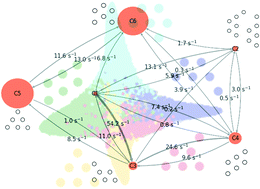Understanding and design of non-conservative optical matter systems using Markov state models†
Abstract
Optical matter (OM) systems consist of nano-particle constituents in solution that, when illuminated with a laser beam, can self-organize into ordered arrays bound by electrodynamic interactions. OM systems are intrinsically non-equilibrium due to the incident electromagnetic flux and may manifest non-conservative forces and interconversion among structural isomers. Rational design of desired configurations and transitions requires quantitative understanding of the relation between the incident beam and the emergent metastable states and isomerization dynamics. We report a data-driven approach to build Markov state models appropriate to non-conservative and permutation-invariant systems. We demonstrate the approach in electrodynamics-Langevin dynamics simulations of six electrodynamically-bound nanoparticles. The Markov state models quantify the relative stability of competing metastable states and the transition rates between them as a function of incident beam power. This informs the design and testing of new beam conditions to stabilize desired nanoparticle configurations. The technique can be generalized to understand and control non-conservative and permutation-invariant systems prevalent in optical and active matter.

- This article is part of the themed collection: MSDE Recent HOT Articles


 Please wait while we load your content...
Please wait while we load your content...